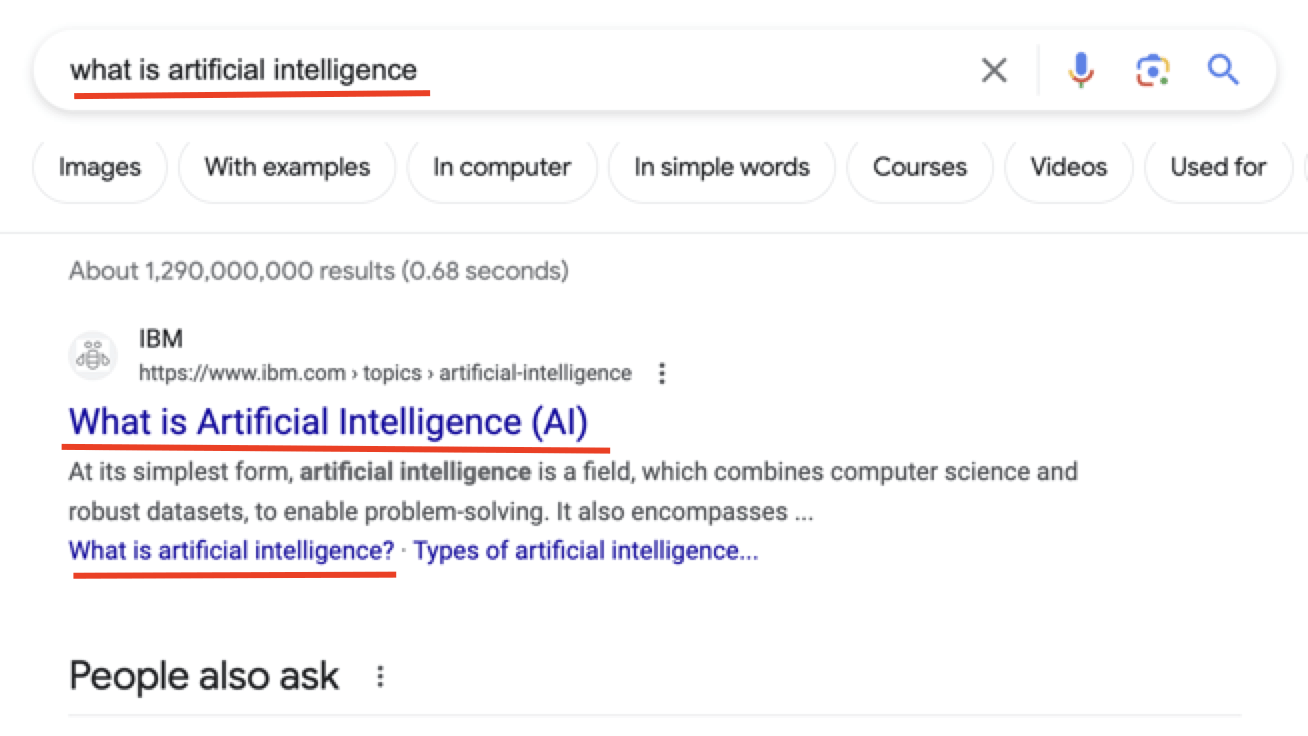White hat search engine optimization (SEO) embraces ethical, user-first tactics for improving your rankings in search results. What is white-hat SEO, though, and how can you get started with it? Keep reading to learn more!
What is white-hat SEO?
White-hat SEO is any practice to improve your site’s rankings in search engine results pages (SERPs) while meeting search engine guidelines.
White-hat SEO vs. black-hat SEO
In contrast to white-hat SEO, we have black-hat SEO. Black-hat SEO is any process that goes against search guidelines to try and improve a website’s ranking in the SERPs.
While white-hat SEO is honest and rule-abiding, black-hat SEO is — at its worst — straight up deceitful.
While white-hat SEO is honest and rule-abiding, black-hat SEO is — at its worst — straight up deceitful. For example, some companies redirect users to unrelated pages, hide content on the page, or use link spamming to improve their rankings. All these examples ruin the user experience.
Many websites attempt to get ahead in the SERPs by using black-hat SEO. However, Google is getting better at detecting these methods, and these sites are often removed from the search index as a result.
Don’t fail your website’s most important test
Get an SEO scorecard of your website for free in less than 30 seconds.
Why use white-hat SEO?
Google Search Essentials — the guidelines for all things search related — break down what to do and what to avoid in terms of your website. They are very specific about what kind of results they want to provide users. They want to offer trustworthy, relevant content to all searchers.
Failing to meet these requirements could lower your rankings or even have you blocked from the SERPs. White-hat SEO keeps you out of trouble with search engines and provides a better experience for users.
If you want your site to have any hope of ranking in the SERPs, you should focus on creating a quality site that naturally encourages traffic. Other white -hat SEO benefits include the following:
- Conserving resources: Imagine you spend tens of hours and hundreds of dollars on your site, just to have it wiped from the search index for breaking the rules. If you want to prevent resource waste, you should stick to white hat tactics.
- Pursuing longevity: White-hat SEO tactics can help you see more results over time. Also, using white hat tactics encourages conversions and sales over a longer period without risk to your site’s standing.
- Building your reputation: Using white hat methods also helps you build your reputation with search engines and users. Both parties will recognize your site as a trustworthy, respectable place for information, products, and services.
White-hat SEO techniques
So, what does white-hat SEO look like? And should you use it? Of course!
Any SEO technique listed in Google’s guidelines is fair game. White-hat SEO will help you rank without breaking the rules. And, generally speaking, white-hat SEO will help you create a better site overall.
Here are a few common white-hat SEO techniques that anyone can do:
Keyword integration
Adding keywords to your website is key to helping your pages rank for those terms. Keywords tell users and search engines what your pages are about. They also help answer intent and make sure that users are getting the content they want when entering a query:

Optimize your keyword integration with these tips:
- Place your target or primary keyword in your title tag, meta description, and H1
- Use your target and related keywords throughout your content
- Watch your keyword density — you don’t want to hurt your content’s readability
While black-hat SEO would have you add these keywords as often as possible, the white hat approach only involves adding them when necessary. Above all, you should focus on the reader’s experience.
Landing page optimization
Your landing pages are the pages users go to when they click on an advertisement or results in the SERPs. When you create landing pages, they should be attractive enough to keep users on the site and encourage them to browse.
Some sites try to trick users by advertising one page and then redirecting traffic to an entirely unrelated page. Instead, you should be as upfront as possible to give users the best experience and encourage them to stay on your site.
When creating landing pages, you should:
- Target relevant keywords
- Use images or designs related to the topic
- Include specific calls to action (CTAs)
Link building
One of the most important methods of white-hat SEO is link building. This area is where many companies look for alternative methods to build links fast since they play a huge role in SEO.
To help build links naturally, you should:
- Create informative content that earns links from other industry sources.
- Ask other sites to link to your content.
- Offer your link as a replacement for broken ones on reputable sites.
- Write guest content and get consent to link back to your site.
- Share your content on social media.
Never buy or trade links from companies. Normally, these links will come from irreputable sites, which only hurts your SEO in the long run.
Page speed
People are like Ricky Bobby when searching online — they wanna go fast.
Give them what they want with these page speed best practices:
- Use a content delivery network (CDN)
- Cache URLs
- Minify code
- Compress images
- Fix 3xx and 4xx errors
While some of these white-hat SEO best practices require a developer, others are ones you can do in your day-to-day. For example, when uploading new content to your site (or sending it for upload), you can include compressed images using a free tool like Squoosh.
Content quality
With Google’s increasing content quality standards (plus the scale of AI-generated content), it’s become vital for webmasters to improve the quality of their content, whether it’s a guide, product page, or blog post.
Make your content more valuable with white-hat SEO techniques like:
- Including insights from your team through quotes, stories, or guest posts
- Adding trust signals, like years of experience, certifications, or case studies
- Sharing first-hand experiences, whether through video or written copy
- Building multimedia assets, like graphics, videos, or GIFs to explain a topic
With AI SEO tools like ChatGPT, Claude AI, and Cursor AI, it’s possible to bring these ideas to life with minimal effort. ChatGPT, for example, can design on-brand graphics for you — or at least the specs for them if working with a freelancer or in-house designer.
Accessibility
People from all over the world can visit your site, and making your site accessible to them (and crawlers) can improve not only your SEO performance but also your conversion rates.
That’s why it’s important to follow accessibility best practices like:
- Generate alt text for images
- Create concise URLs that describe the page and separate words with dashes
- Maintain sufficient color contrast (like between your background and font color)
- Include breadcrumb navigation (like Home > Products > Movies & TV)
If you’re looking for a fast answer on your site’s accessibility, use an ADA compliance checker. You can also install a website plugin, like accessiBe, that gives users different controls for viewing and customizing your site.
Website architecture
Another best practice for white-hat SEO focuses on your site’s architecture. Like a city map, your architecture helps crawlers and users navigate your website (or city), which can benefit your rankings, user experience, and conversion rates.
Build a better site architecture with tactics like:
- Create a logical hierarchy, like /products/books/nonfiction/
- Place URLs in the navigation and/or footer that matter the most
- Connect URLs via internal links
- Give URLs concise, but descriptive names
You can start building your site’s layout with a free tool like Octopus.do.
Improve your SEO approach with SEO.com
Looking to implement effective white-hat SEO strategies? Learn how our expert team can help you enhance your online visibility and achieve your SEO goals by contacting us online today!
Let’s Drive Results Together 

Meet
Connect with us, today!
Writers

Related Resources
- What is SEO? Learn the Essentials of Search Engine Optimization
- What is SSL and Why Do I Need It for My Website?
- What is User Experience (UX)? Everything You Need to Know
- What is Website Traffic? Definition & How You Can Track It
- Google Tag Manager: What is It, and What Can It Do?
- Long-Tail vs. Short-Tail Keywords: the Ultimate Guide for Beginner’s
- Share of Voice: Definitions, Calculations, and Importance
- Understand Email Marketing Statistics to Improve Your Impact
- What Are Backlinks? Definition, Tips, and More
- What Are Breadcrumbs? Definition and How to Use Them


